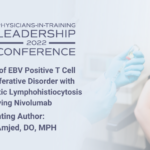Abstract | April 4, 2022
A Rare Case of EBV Positive T Cell Lymphoproliferative Disorder with Hemophagocytic Lymphohistiocytosis Receiving Nivolumab
Learning Objectives
- Discuss the importance of recognizing HLH related disease processes;
- Diagnose and treating chronic active EBV.
Introduction: Epstein-Barr Virus (EBV) can range from asymptomatic to infectious mononucleosis to multi-organ failure (3). Some individuals are unable to control EBV infection due to infiltration of tissue by EBV positive T, NK, and B cells, termed chronic active EBV (CAEBV). Diagnosis includes increased EBV level with no known underlying immunodeficiency (4). CAEBV is quite rare in the U.S. (1). Hemophagocytic lymphohistiocytosis (HLH) can occur as a devastating complication in patients with CAEBV and involves dysregulation of NK cells, CD8+ cytotoxic T cells and macrophages (5). EBVassociated HLH is rare, with an approximate annual incidence of 0.4 cases per million persons (2).
Case Presentation: A 20-year-old male with no medical problems presented with two days of diffuse abdominal pain, vomiting, and fevers. Vitals were BP of 93/49, HR 105, RR 20, and 100% O2sat on RA. Labs were significant for platelet count of 37, AST 331, ALT 166, ALK 319, BUN 60, Cr 2.9, and lactate of 6.2. HIV, HSV, CMV, COVID-19 were negative. A chest x-ray was unrevealing. A RUQ ultrasound showed pericholecystic fluid and mild extrahepatic biliary ductal dilatation. An initial diagnosis of septic shock with unknown etiology was made. He received 30 cc/kg of IV crystalloid and broad-spectrum empiric antibiotics. He later developed DIC requiring resuscitation with numerous blood products.
Final/Working Diagnosis: EBV DNA by PCR returned positive with 9.98 million copies/mL, suggesting a diagnosis of CAEBV. Ferritin was 21,2155.7 ng/ml. Bone marrow biopsy confirmed EBV positive T cell lymphoproliferative disorder with HLH. Atypical proliferation was positive for CD3, CD5, CD8, CD20 and granzyme B and negative for CD4, perforin, TCRD and CD56. EBER ISH showed focal positive cells. Flow cytometry identified 64% abnormal mature NK- cell population. Management,
Outcome and Follow Up: He was treated with etoposide, rituximab, and dexamethasone and emapalumab-Izsg. He remained stable and was discharged with close outpatient follow-up. CHOP protocol was initiated along with nivolumab with improvement of EBV viral load to 2.76 million copies/ml. He is currently awaiting HSCT.
References and Resources
- Cohen JI. Optimal treatment for chronic active Epstein-Barr virus disease. Pediatr Transplant. 2009;13(4):393-396. doi:10.1111/j.1399-3046.2008.01095.
- George MR. Hemophagocytic lymphohistiocytosis: review of etiologies and management. J Blood Med. 2014;5:69-86. Published 2014 Jun 12. doi:10.2147/JBM.S46255
- Hoover K, Higginbotham K. Epstein Barr Virus. [Updated 2020 Nov 20]. In: StatPearls [Internet]. Treasure Island (FL): StatPearls Publishing; 2021 Jan.
- Kimura H, Cohen JI. Chronic Active Epstein-Barr Virus Disease. Front Immunol. 2017;8:1867. Published 2017 Dec 22. doi:10.3389/fimmu.2017.01867
- Konkol S, Rai M. Lymphohistiocytosis. [Updated 2021 Mar 27]. In: StatPearls [Internet]. Treasure Island (FL): StatPearls Publishing; 2021 Jan

